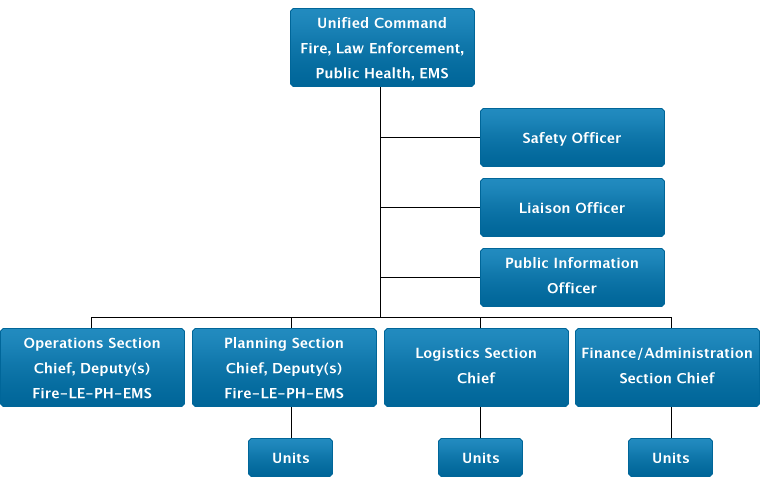Type 3 Incident Management Team (IMT) Program Overview
IMT Descriptions
In August 2003, USFA convened a Focus Group of stakeholders and experts from across the country to best determine the means to develop Type 3 incident management teams (IMTs) across the country. The Focus Group agreed to stay with the basic National Wildfire Coordinating Group (NWCG) Incident Command System (ICS) training and typing models for the all-hazards emergency response community. The IMT typing descriptions are as follows:
- Local IMT
- A single and/or multi-agency team for expanded incidents, typically formed and managed at the city or county level or by a pre-determined regional entity. It is a designated team of fire, EMS, Department of Public Works, Public Health, and/or law enforcement personnel from a larger and generally more populated area, typically within a single jurisdiction (city, county, or region), activated when necessary to manage a major or complex incident requiring a significant number of local and mutual aid resources, such as a major structure fire, a multi-vehicle crash with multiple patients, an armed robbery, or a hazardous materials spill. It may also be activated for public events. A Local IMT usually is comprised of 7-10 trained personnel who respond to incidents that are typically contained within one operational period in the control phase, usually within a few hours after resources arrive on scene, but may initially manage larger, more complex incidents prior to arrival of a Type 3, Type 2, or Type 1 IMT.
- Type 3: State or Regional multi-agency / multi-jurisdiction team for extended incidents
- A multi-agency/multi-jurisdiction team for extended incidents, formed and managed at the State, regional or metropolitan level. It is a designated team of trained personnel from different departments, organizations, agencies, and jurisdictions within a state or DHS Urban Area Security Initiative (UASI) region, activated to support incident management at incidents that extend beyond one operational period. Type 3 IMTs are deployed as a team of 10-20 trained personnel to manage major and/or complex incidents requiring a significant number of local, regional, and state resources, and incidents that extend into multiple operational periods and require a written Incident Action Plan (IAP), such as a tornado touchdown, earthquake, flood, or multi-day hostage/standoff situation, or at planned mass-gathering events. A Type 3 IMT may also initially manage larger, more complex incidents that are later transitioned to a Type 2 or Type 1 IMT.
- Type 2: National or State team for incidents of regional significance
- A self-contained, all-hazard or wildland team recognized at the National and State level, coordinated through the State, Geographic Area Coordination Center, or National Interagency Fire Center. All personnel meet the NWCG training regimen at the Type 2 level for their specific position. A Type 2 IMT is deployed as a team of 20-35 to manage incidents of regional significance and other incidents requiring a large number of local, regional, state, and national resources. This includes incidents where Operations Section personnel approach 200 per operational period and total incident personnel approach 500. Several dozen Type 2 IMTs are currently in existence, and operate through the U.S. Forest Service.
- Type 1: National or State team for incidents of national significance
- A self-contained, all-hazard team recognized at the National and State level, coordinated through the State, Geographic Area Coordination Center, or National Interagency Fire Center. All personnel meet the NWCG training regimen at the Type 1 level for their specific position. A Type 1 IMT is deployed as a team of 35-50 to manage incidents of national significance and other incidents requiring a large number of local, regional, state, national, and Federal resources over multiple operational periods. This includes incidents where Operations Section personnel may exceed 500 per operational period and total incident personnel may exceed 1000. Eighteen Type 1 IMTs are now in existence, and operate through the U.S. Forest Service.
The Focus Group recommended that a Type 3 IMT course for team development be developed. The goal of this technical assistance program (TAP) is to provide the necessary tools for individuals to perform as members of a Regional or State Type 3 IMT at major and/or complex incidents requiring local, regional, state, and possibly Federal resources. The Focus Group also recommended a framework upon which local agencies or groups of local disciplines can build Local IMTs. The goal of this TAP is to provide the necessary tools for individuals to perform in appropriate ICS Command and General Staff positions during local incidents, and to transition to a higher level, more robust team if necessary for incidents expected to extend beyond the first operational period.
Incident Management Team Structure

IMT Development Concept
- Recommended for assigned members of Type 3 IMTs:
Appointed by Metropolitan, Regional, or State Authority Having Jurisdiction.
ICS 100, ICS 200 (Web-based or classroom) or equivalent
ICS 300, ICS 400 or equivalent (National Fire Academy's Command and General Staff Functions for Local IMTs (O337) is equivalent)
All-Hazard IMT (O305) offering, customized simulation (50-hour on-site); or S-420
ICS position-specific professional development
Field mentoring
Audience: Approximately 106 Type 3 IMTs across the country (50 UASI regional areas and 56 states/territories)
For additional information, see the NIMS/Incident Management System Integration Division (IMSID) 5 Year Training Plan.
A flowchart showing the inter-relationship of IMT training is provided below.
Incident Command System/Incident Management Team Training Flowchart


